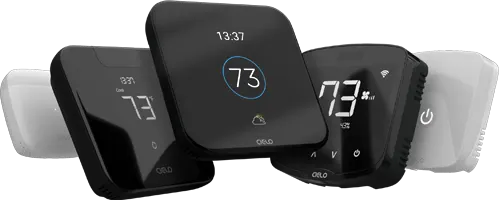Hydronic heating systems are one of the most energy-efficient systems out there.

Key Takeaways
- Hydronic heating uses a boiler to heat water, which is then circulated through pipes to radiators or baseboards.
- These systems are highly efficient and provide even heat distribution.
- Installing a hydronic system is highly expensive.
If you’ve ever walked into a home that is just the right temperature but doesn’t have one vent or heat pump in sight and wondered what their secret is, it’s this – a hydronic heating system!
Hydronic heaters are an ideal solution if you’re looking for an energy-efficient and clean heating system for your home. Like any other system out there, this, too, has perks and downsides. But before we can get to that, let’s first look into what hydronic heating is and how it works.
What Is Hydronic Heating?
Hydronic heating is a type of heating system that relies on water rather than air to distribute warmth.
A hydronic heater constitutes a heat source like a boiler and a network of tubes that transport the heated fluid to other parts of your home using systems like radiant floor heating or radiators.
Many residential homes in the north have also adopted this system due to their long heating seasons. People living in areas with shorter heating seasons also use this system on a much smaller scale.
How Do Hydronic Heating Systems Work?

Hydronic heating begins with a heat source, which can be a boiler powered by electricity, natural gas, or propane, or a heat pump. Once the water is heated, it is then circulated through a network of pipes to your heating system, which can be a radiator unit, baseboard heater, or radiant floor heating system. As the hot water flows through these systems, it radiates heat into your surrounding space. Once the water has transferred its heat, it cools down and returns to the boiler, where it is reheated, and the cycle repeats.
Modern hydronic systems have advanced high-efficiency boilers and smart controls that regulate water temperature based on outdoor conditions. This control is known as outdoor reset or hot water reset. It monitors the real-time outdoor temperature and communicates it to the boiler. This enables the boiler to adjust the temperature of the water, increasing or decreasing it as needed based on the outdoor conditions. This makes hydronic heating one of the most efficient options available in the market.
Components of Hydronic Heating Systems
Hydronic heaters have seven basic components that work together to work efficiently. In addition, these components can have several variations that allow you to customize the system according to your needs.
1. Boiler
The boiler is the central part of your system and is the means to heat the liquid.
2. Liquid Medium
Traditionally, most systems use water as a heat transfer medium, although some can use other liquids or antifreeze mixes.
3. Thermostat
It controls the temperature in the system and decides when to turn the system on or off to control the climate better.
Equip your HVAC system with smart features and achieve the perfect balance between comfort & savings.
Learn more
4. Manifold
A plumbing manifold is a hub for directing the water flow in the system and is connected to the thermostat.
5. Tubing
The tubes for carrying the liquid medium are usually made of PEX (cross-linked polyethylene) or some other form of plastic rather than copper or different types of rigid tubing.
6. Heat Exchanger
A heat exchanger transfers the heat from the pipes to the inside of the house.
7. Pump
To maintain a steady flow of heated liquid and constantly replenish the room’s warmth, a pump is used to push the fluid through the pipes.
Types of Hydronic Heating Systems

-
Hydronic Radiant Floor Heating
Hydronic radiant floor heating warms a space from the ground up by circulating hot water through a network of tubing installed beneath the floor. The heat radiates evenly across the floor surface, warming the room efficiently and comfortably. This system is typically powered by a boiler, which heats the water before it is distributed through the tubing.
-
Hydronic Baseboard Heater

The baseboard hydronic heaters use a boiler that heats up the water and sends it through the baseboard heaters installed in individual rooms. As the hot water moves through the baseboard system, it radiates warmth into your space, ensuring steady and even heating. Each unit is equipped with a thermostat, allowing you to control the temperature individually and heat only the rooms that are in use.
-
Hot Water Radiator
The hydronic heating radiators function much like baseboard heaters; they just use radiator units instead of baseboard heaters. They work by circulating heated water through a network of pipes into radiator units, which then transfer heat into the surrounding air. These radiators are commonly found in homes and buildings that use a boiler system. As the water cools, it returns to the boiler to be reheated and circulated again.
-
Hydronic Wall Heater
The radiant wall heaters work similarly to radiant floor heating, where warm water circulates through pipes or panels embedded in the walls. The heated walls then radiate warmth into the room, providing comfortable and even heating.
Benefits of Hydronic Heating System
Hydronic heating systems are very efficient, but that’s not all. These systems have a myriad of benefits.
1. No Dust, Pollen, or Allergens
Forced air heating pushes air into your room to regulate the climate. Unfortunately, this airflow can often bring dust, pollen, pet dander, or other indoor air pollutants, or the brisk moving air can stir up allergens in the room. If you don’t maintain your ducts or air filters regularly, this situation can worsen. On the other hand, hydronic heating systems do not rely on ducts, don’t displace air, and are much cleaner.
Related: Radiant Heat Vs. Forced Air – Which Is the Better Option?
2. Energy Efficiency
Air isn’t the best heat conductor. It can lose energy as it travels through ducts or leaks through gaps, leading to heat loss. In contrast, water needs less energy to heat since it absorbs heat better and retains the heat for longer.
3. Create Separate Zones
Hydronic systems let you create different temperature zones to enhance your comfort.
For example, rather than having one thermostat in your entire home, you can have a dual-zone thermostat to vary temperatures in different rooms. Zones are a great idea if you live with someone who has other temperature preferences than yourself.
4. Ideal Humidity Levels
Forced air heating can draw moisture out of the air, leading to unbalanced humidity levels in your home. Hydronic heating systems don’t dry out your home since they use a liquid in a closed system to heat your home, maintaining ideal humidity levels.
5. Warm Floors

If you have hydronic floor heating installed, you no longer have to dread getting out of bed on those cold mornings. Tubes can be placed under the flooring or in concrete slabs, and the floor acts as a conductor to keep you comfortable.
6. Quiet Operation
Hydronic systems do not displace air to warm your home, unlike forced-air heating systems. So not only do you not need to stay listening to the rush of air as it passes through the system, but you also don’t have to worry about the sounds of a furnace firing up or groans from the cold ducts as warm air passes through them. So, you’re pretty much rid of all the various sounds you have to bear in other heating systems.
7. No Ducts
Ductwork can take up quite a bit of space in your walls and ceilings. Additionally, ducts can also be expensive and messy to install and maintain. Instead, hydronic heating system tubes can be installed in the wall or attached to floor joists. These pipes can also be routed around the existing pipework.
8. Durability
Traditional HVAC systems have a lot of moving and mechanical parts, which means they need repairs more often. Instead, hydronic heating systems do not have many mechanical parts, do not need much maintenance, and are more likely to last a long time.
9. Even Heating
Forced air heating systems use air displacement to keep you warm. However, these systems move air briskly, and the subsequent drafts and breezes may result in uneven heating or cooling around your home. Hydronic heating systems eradicate this issue by using radiant heat to keep you warm.
Disadvantages of Hydronic Heating System
Hydronic systems have many perks, but they aren’t without their downsides.
1. Long Heating Time
While water does absorb heat better than air, the heated water needs to travel through the whole system to warm your home up. This process can take quite a long time, and you’ll have to wait longer to benefit from the warmth. Due to this issue, hydronic heating systems are better suited for moderate climates or when consistent temperatures are needed.
2. May Not Go With Your Aesthetics
Baseboard hydronic systems and radiators require additional space on the wall and can clash with your interior design.
3. Require Regular Maintenance
All closed-loop water heating systems need an expansion tank for safety. These tanks have to be occasionally drained to work efficiently. Additionally, baseboard heaters and radiators should be cleaned regularly, as they tend to accumulate dust over time.
4. Hard to Access Piping if a Problem Comes Up
With hydronic heating systems, there’s a slight risk that pipes in the system might leak or burst. While this is a highly unlikely situation, it still poses a threat to the system’s working and your home’s building elements. In addition, the pipes are hidden away under the floor or behind the walls or ceiling, making repairs of this sort a difficult and expensive process.
5. Higher Installation Costs Upfront
Installing a hydronic heating system into an already-built home can be very expensive. It requires professional builders, and you will need access to your floor joists. The alternative is to remove the floor or the drywall and then reinstall them with the system installed. If you’re looking to refurbish your home or are building a new house, installing the system in those instances won’t be as cost-restrictive.
6. No Ductwork for Air Conditioning
Since radiant cooling isn’t a widely popular or efficient system, most people only use hydronic systems for heating. So, if you live in an area where you would like central air conditioning, opting for radiant heating isn’t a good idea. In addition, installing two separate systems for heating and cooling is quite expensive.
8. Requires Careful Planning Before Installation
Extensive planning is necessary to ensure that a hydronic heating system will work efficiently. For instance, it’s important to keep the warming elements closer to the ground where people are when installing radiant wall heating. If they’re too high up, the generated heat will be of no use to the inhabitants of the room since radiant heat only warms objects in its line of sight.
10. Furniture Can Be a Hindrance
Radiant heating warms objects by radiation, and the things need to be in the line of sight for them to work efficiently. For example, furniture pulled up against the wall (in the case of radiant wall heating) or thick carpets that act as insulators can bring down the heating abilities of the system.
In Conclusion
Hydronic heating systems are a great option for anyone looking for energy-efficient and even heating. There are many benefits these systems offer other than energy efficiency, such as quiet and clean heating. However, hydronic heat systems also have downsides like an expensive upfront installation cost and air stagnation. But, all in all, these units are quite efficient!









1 Comment. Leave new
My father recently told me that his hydronic heating system hasn’t been operating the same way it used to. I should find a repair service to help fix it for him, especially now that the weather is getting colder.